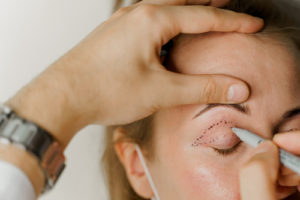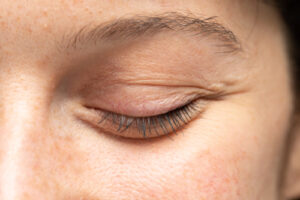Eyelid surgery, also known as blepharoplasty, is a transformative procedure that addresses concerns related to sagging or puffy eyelids. At Reflections at St. Luke’s, our skilled surgeon, Dr. Villanustre, offers blepharoplasty, aiming to rejuvenate and enhance the appearance of the eyes, helping you achieve a more youthful and vibrant look.

Blepharoplasty is a procedure that aims to remove excess skin from the eyelids. As you age, the eyelids tend to stretch, and the supporting muscles may weaken, leading to sagging.
This procedure effectively addresses these issues, enabling the eyes to open wider and, in many cases, restoring vision that may have been previously obstructed. There are two types of blepharoplasty procedures: upper blepharoplasty and lower blepharoplasty.
Upper eyelid blepharoplasty is a transformative surgical procedure aimed at rejuvenating the upper eyelids. One key advantage is that it can be performed under local and IV sedation, making it a safer and more accessible option for a broader range of patients. Upper eyelid blepharoplasty, commonly known as an “eyelid lift,” focuses exclusively on the upper eyelids. The procedure removes excess skin and addresses issues like drooping eyelids. It is designed to enhance the aesthetic appearance and, in some cases, improve superior and peripheral vision. Dr. Villanustre strategically makes incisions along the natural creases of the upper eyelids to ensure minimal scarring. Excess skin and sometimes fat are removed, and the incisions are closed with fine, absorbable sutures.
Lower eyelid blepharoplasty is a cosmetic surgery that focuses on the rejuvenation of the lower eyelids. It is designed to address issues such as excess skin, and puffiness/fat herniation, which can give the eyes a tired or aged appearance. Fat herniation occurs when the fat pockets that naturally exist around the eyes protrude and create bags or bulges. One of the key techniques used in lower eyelid blepharoplasty is the transconjunctival approach. This approach involves making an incision inside the lower eyelid, hidden from view, which minimizes the risk of visible scarring. Dr. Villanustre will then access and reposition or remove excess fat while preserving the structural integrity of the eyelid and at the same time a laser resurfacing is done on the outside of the lower eyelid skin to address to polish and repair the skin as is shown on these before and after.
Apart from the functional benefits, blepharoplasty can enhance the appearance of the eyes, giving them a more alert and youthful look.
Before the blepharoplasty procedure, Dr. Villanustre will administer anesthesia to the necessary areas to ensure that you are comfortable. The next steps will vary depending on whether you have upper eyelid blepharoplasty or lower eyelid blepharoplasty.
If you’re having an upper eyelid blepharoplasty to correct upper eyelid drooping, Dr. Villanustre will start by making precise incisions along the natural creases of the upper eyelids. If you’re having a lower eyelid blepharoplasty, he will make the incision below the lashes of the lower eyelids.
These incisions are strategically placed to minimize visible scarring. Excess skin, fat, and sometimes muscle tissue are carefully removed to address issues like sagging, puffiness, and wrinkles around the eyes.
The remaining skin and muscles are skillfully tightened and reshaped to achieve a more youthful and rejuvenated appearance. After making the necessary adjustments, he will close the incisions with sutures.
Throughout the procedure, which typically takes one to two hours, Dr. Villanustre will pay close attention to detail and precision to achieve the desired outcome. Following the procedure, you will receive instructions to follow during your recovery to aid in healing and minimize discomfort.
Blepharoplasty offers both functional and cosmetic benefits, leaving you with more open, vibrant-looking eyes and a renewed sense of confidence.
After blepharoplasty, you may experience mild bruising and swelling around the eyes, which typically subsides within a few weeks. Following your post-operative instructions, such as applying cold compresses and keeping the head elevated, is essential for a smooth recovery.

Stitches are usually removed within a week. It’s also important to avoid strenuous activities, like exercise or lifting heavy things, during the initial healing phase.
You can expect to see improvements gradually, and final results become apparent as swelling reduces. Most people who have the blepharoplasty procedure can resume regular activities within a few weeks.
You will need to see Dr. Villanustre for a few follow-up visits after your eyelid surgery in Tarpon Springs. During these visits, he will ensure that your eyelids are healing well and that the procedure was successful.
In order to determine if you’re a good candidate for blepharoplasty or if this procedure may be able to accomplish your goals, you will need to visit Dr. Villanustre at Reflections in Tarpon Springs, Florida, for a consultation. Determining whether you are a candidate for blepharoplasty depends on various factors.
Ideal candidates for blepharoplasty are those who are bothered by drooping or puffy eyelids, excess skin, and fat deposits around the eyes, which may interfere with their vision or cause a tired, aged appearance. Age is not the sole factor in determining if you are a good candidate.
However, a good candidate should be in overall good health, have realistic expectations, and understand the potential risks and benefits of the procedure. Dr. Villanustre will conduct a thorough evaluation, considering your medical history and eye health, to determine if blepharoplasty is suitable for achieving your desired results.

Are you interested in learning more about blepharoplasty or determining if you may be a good candidate for this procedure? Schedule an appointment at Reflections at St. Luke’s in Tarpon Springs or Clearwater, FL, today!